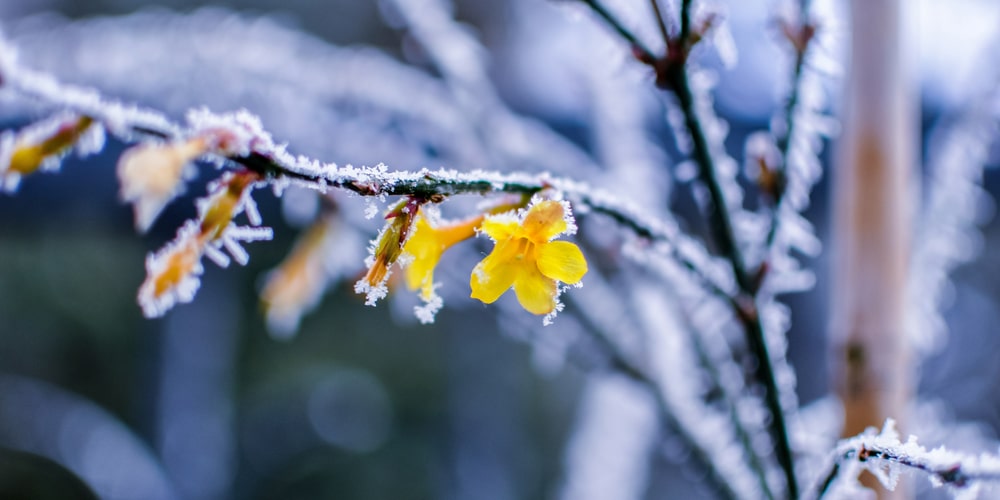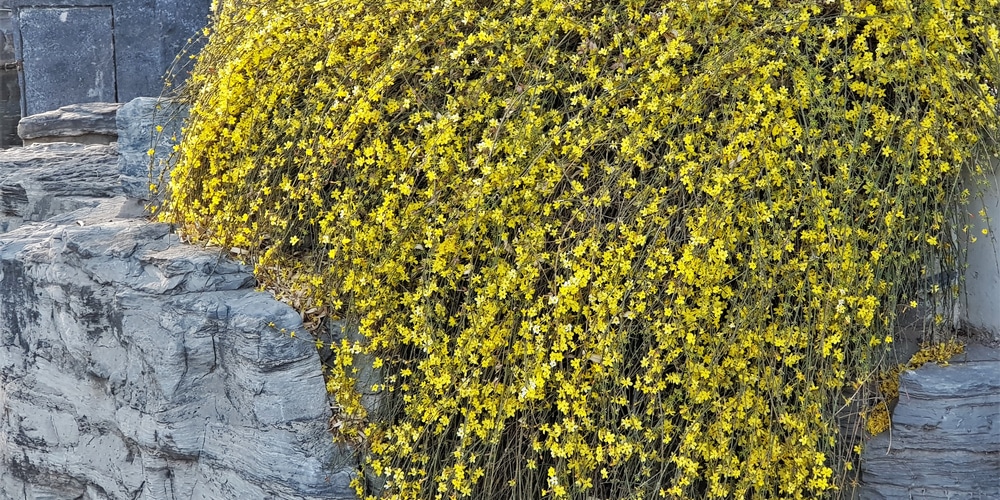Winter jasmine is originally from China, where it grows in tropical and sub-tropical regions. It’s also common in other areas of Asia such as Japan and Korea. The plant has been in cultivation in the United States for over 150 years. This plant can easily be recognized by its fragrant yellow blossoms that bloom in the winter and its glossy dark green leaves. The plant is propagated by cuttings taken in the summer and is an excellent addition to a winter garden. Let’s look at how to grow and care for a winter Jasmin plant.
What is Winter Jasmine?
Winter Jasmine has the botanical name Jasminum nudiflorum and is part of the Oleaceae family with over 200 species. Winter Jasmin is a vigorous evergreen shrub with glossy foliage. The leaves of this vine also smell like jasmine when bruised or crushed.
Winter jasmine has small trifoliate leaves and fragrant yellow flowers which bloom in the winter months. The plant is a flowering vine that will grow from 3 ft to 4 ft tall indoors with an equal spread if given proper care. If grown outside, this plant can get much larger and may grow as tall as 10 or 15 feet high with the right support.
How to care for a winter jasmine plant?
Jasminum nudiflorum is easy to care for as long as it has bright light during the day and cool temperatures at night of between 50 and 65 degrees Fahrenheit. Water the plant only when the soil is dry to the touch. Try not to get water on the flowers because moisture can damage them. Your jasmine should be repotted every two years in the spring or if it looks rather pot bound. Here are some tips to help you grow a thriving winter jasmine plant that will look beautiful for years to come:
Sunlight needs
A particularly good site for this plant is an east or west-facing windowsill where it can receive bright indirect light during the day. If you place your jasmine in a spot with too much sun, you should be aware that the plant may become leggy.
Watering Requirements
Water plentifully as needed, depending on the season and weather conditions. You’ll find that winter jasmine needs very little water in winter, but regular watering in summer if kept in a container. Avoid overwatering, or your plant could suffer from root rot. It’s best to test the soil with your finger and allow the soil mix to become nearly dry between watering’s.
Temperature
Jasmine does not like drafts and should never be kept where temperatures fall below 40°F for prolonged periods. In order to promote flowering, the temperature should remain between 60 to 65° during both day and night. This plant will not grow well where there are low night temperatures below 50F/10C or extended periods of cool or cold weather. In these situations, it may have a tendency to drop leaves and will eventually die. These plants can grow outdoors year-round in USDA zones 7 and 8. In colder climates, they can be kept as a houseplant or brought inside for overwintering.
Soil
Winter jasmine as a houseplant requires a well-draining mixture of 1/2 peat moss, perlite, and compost, which is kept moist but never soggy. These plants can cope with a wide range of soil types from slightly acidic, neutral, or slightly alkaline. The soils pH range can be between 5.6 to an alkaline 7.5.
Pruning
Be sure to pinch back the plant several times throughout the summer to remove dead or damaged leaves and encourage bushiness and side branching. You can also prune your plant in the fall to help maintain its shape and size. However, the timing of this should be carefully watched because it will suffer from frost damage. The ideal time to prune is when there are no longer any new flowers emerging.
Pests and disease
The plant does not have any serious pest or disease problems but is susceptible to leaf spot and can be affected by scale infestation, aphids, and mealybugs which are generally the result of poor air circulation. Keep an eye out for white cottony masses on the stems of your jasmine; this might indicate powdery mildew, which is a fungus disease. Pests and diseases can be treated using the correct fungicide or insecticidal spray. You can also use neem oil to get rid of insect infestation.
Humidity
Consistent humidity is also advantageous. Aim to keep the humidity around 50 to 70%. However, these plants are relatively hardy and can cope with humidity outside this range. If you live in a very dry climate, it may be worth misting your plant from time to time.
Fertilization
Use a general-purpose fertilizer once a month during the growing season. Avoid fertilizing your plant in fall or winter as it will start to go dormant to conserve energy during the colder months. Alternatively, use a slow-release fertilizer once or twice annually. Always follow the manufacturer’s instructions when applying fertilizer.
Propagation
The best time to propagate your plant is in the spring. It can be propagated by seed or stem cuttings. Seeds are usually very slow and erratic, but you might want to try them if you have enough patience. The easiest way to propagate this winter jasmine is by taking 2-3-inch-long tip cuttings during the summer months, which should root within three weeks under mist conditions.
Conclusion
winter jasmine is a beautiful evergreen climber that needs bright light conditions during the day and cool, airy night temperatures. Keep young plants in cool areas and away from direct sun; as they age, give them protection from the strong afternoon heat and full sun.
Winter jasmine prefers growing in the spring and summer seasons, but it can be grown all year round indoors or outdoors if given proper care. It is resilient to many forms of damage and attracts bees and butterflies with its flowers.

